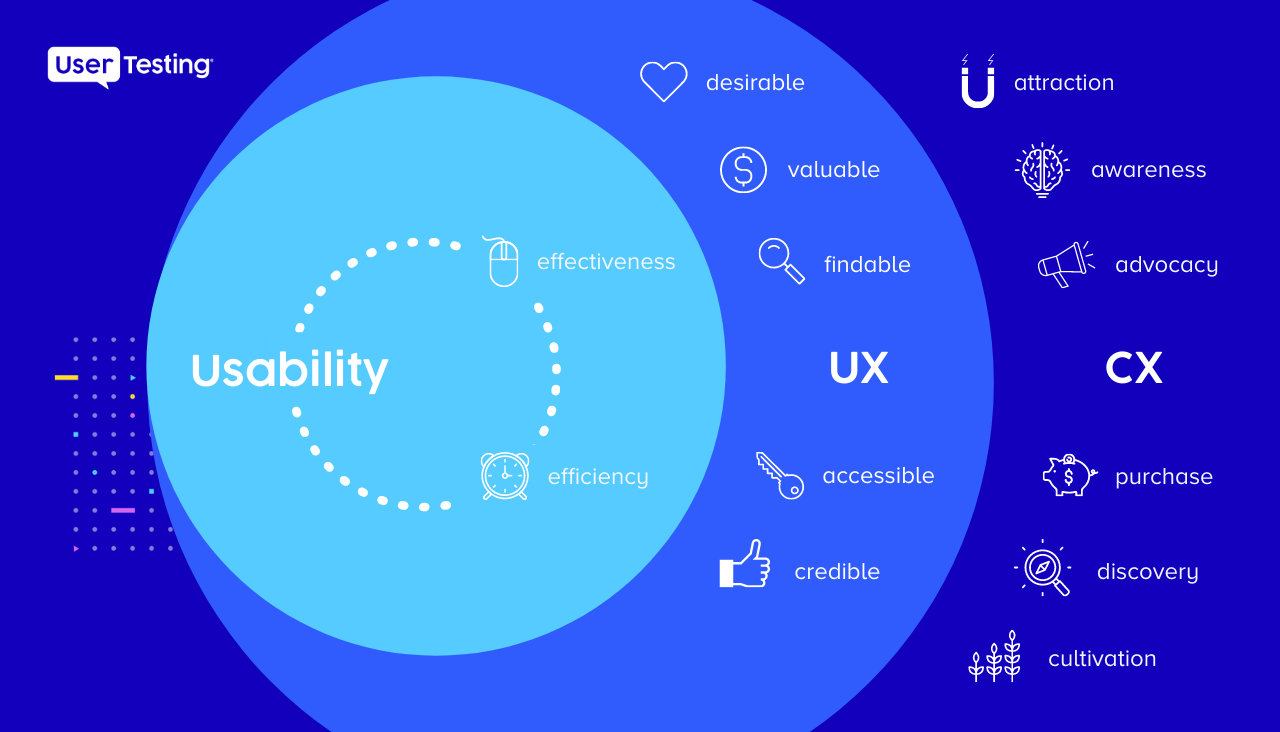
CX vs. UX: what’s the difference?

While user experience (UX) and customer experience (CX) aren’t the newest acronyms born out of the digital world, they’re arguably the most important. The two terms are often confused and used interchangeably. While not mutually exclusive, there are important distinctions to make about CX vs. UX. TL;DR: UX is a part of CX. CX is a 360°, holistic view of the customer journey and seeks to fill in empathy gaps that UX might leave out.

Jump to a section:
- CX vs. UX: here's the difference
- What's a UX professional vs. a CX professional?
- Testing for UX vs. CX
- CX vs. UX metrics
- Turning UX and CX into differentiation
- Conclusion
CX vs. UX: here’s the difference
Before we jump straight into their differences, one thing that CX and UX want you to know is that your customers don’t care what the terms mean.
However, customers do care about their experience with your company. According to a PwC study, consumers have such a low tolerance for bad experiences at any touchpoint that 17% will abandon a brand after a single bad experience, and 59% will give up after several.
As consumer expectations for brands deepen, let’s talk about what we mean by UX and CX.
User experience; you're not your user
In 1993, Don Norman coined the term “user experience” while working for Apple. According to Norman, designing appropriate technologies is far more complex than people realize because we have a terrible tendency to:
- Focus on the technology itself rather than on the context of its use
- Think we understand the way the technology is going to be used
Norman’s message for researchers, designers, marketers, and product managers is that:
We have to understand that we don’t inherently understand other people. Even if another person is like us in every obvious way, they are unlike us in one very special way.
That’s why the first requirement for an outstanding user experience, according to the Nielson Norman Group, is to meet the exact needs of the customer without fuss or bother.
The history of UX
Despite coining the phrase in the early 90s, the field was much older. According to NN/g, Bell Labs was one of the pioneers in making the transition to what we might call designing for interactive systems. In 1945, the company started with the first psychologist hired to design telephone systems. By the 1950s, Bell Labs did UX work on the design of the touchtone keypad. The fact that we still use it today is a big win for UX.
Related Reading: UI vs. UX: What’s the difference between the user interface and user experience?
In the late 90s, usability and user-centered design (UCD) were the terms most people used to describe an effort to design with the user in mind. While here’s the ISO official definition of usability, in his book Don’t Make Me Think Revisited, Steve Krug writes that “usability” was designing things in a way that enabled people to use them successfully.
In a different camp, “information architecture” ensures content is organized to allow people to find what they need. While UCD focused on designing the right product and making sure it was usable, UX sees its role as taking the user’s needs into account at every stage of the product lifecycle.
The evolution of the U in UX
Even today, the concept of UX could stand a refresher. Unfortunately, one of the most important end-users of the digital era is the one most forgotten—your employees.
Employees have a massive impact on your CX, as evidenced by elite CX companies. Fostering an emotional connection with the people that represent your brand to your customers every day should be more top of mind for companies.
For example, USAA takes customer empathy to the next level. The financial services company that exclusively serves families and veterans of the United States Armed Forces requires employees to spend a day at boot camp eating MREs and taking orders from a drill sergeant. While seemingly extreme, the experience helps give employees the context and empathy required to serve their customers. It also drives powerful connections between colleagues.
Customer experience; you're not your customer
Despite setting out to cover every customer touchpoint, things eventually get to where “UX” is too limiting of a term to describe the experience that company’s want to give their customers.
The history of CX
But wait, you ask? If UX includes every single touchpoint the user has with a company, what could CX possibly refer to?
According to Kim Salazar, while UX was initially meant to describe the totality of users’ interactions with an organization, its interpretation became limited over time. Due to its creation in an era where computers were the main form of digital interaction, the true meaning of UX has gotten lost. Where the term UX eventually fell short, the term customer experience (CX) tries to get right—shining the spotlight back onto the customer.
If you’re doing CX correctly, you involve all the different touchpoints that make up the customer journey.
Understanding CX today
As a relatively new term, CX still has some growing up to do. Recently, Gartner spent several months discussing, debating, and building a consensus for changing their definition of customer experience management (CXM).
Previously, the Gartner definition for CXM had been: the practice of designing and reacting to customer interactions to lift satisfaction, loyalty, and advocacy.
While self-admittedly less succinct, Gartner’s new definition seeks to capture the scope, goals, and scale of enterprise-wide CXM:
“CXM is the discipline of understanding customers and deploying strategic plans that enable cross-functional effort and customer-centric culture to improve satisfaction, loyalty, and advocacy.”
Gartner further notes that the changes they observed when developing their understanding of CXM included how companies:
- Gather, analyze, and disseminate customer understanding
- Practice CXM as a discipline that demands continuous investment, a system of governance, and delivers measurable outcomes
- Commit to developing a customer-centric culture
Naturally, our understanding of what it means to be a customer-centric organization will continue to evolve along with the context that it lives in.
What’s a UX professional vs. a CX professional?
Both CX and UX battle to keep the customer centered, and the way they accomplish that goal often overlaps.
UX professional
These days, those who call themselves UX professionals are focused on making a product easy and enjoyable to use. They want users to achieve or complete a desired goal or task and feel great about the experience.
UX professionals’ products range from websites, voice, augmented and virtual reality apps, and even non-digital formats like physical forms of marketing materials.
CX professional
CX Professionals are responsible for creating a brand-level experience that anticipates and supports customers’ needs across the customer journey and all touchpoints. This includes interactions via phone, in person, and anything digital as well.
As a holistic view, CX connects the people who create and deliver a compelling brand promise with the people who benefit from it—their customers. So, you can see that the customer experience includes UX and so much more.
In essence, CX professionals focus on ensuring the entire customer experience is positive and seamless. They surface and address pain points and areas of opportunity while ensuring that the business’s goals align with the actual customer wants and needs.
Testing for UX vs. CX
To keep the customer-centered, UX and CX take different approaches to meeting the end goal. Here’s how you can test for each.
Testing for UX: creating products that are enjoyable and easy to use
When building a great user experience, the focus should be on making the product enjoyable and easy to use. Conduct usability tests to uncover if it’s possible to accomplish specific goals and tasks in the way intended.
Through usability testing, designers, product managers, marketers, and researchers alike can uncover and understand how real people respond to products and experiences. From what they like and dislike to where they get stuck and confused, the valuable insight gathered from these tests can be eye-opening to areas of improvement.
One of the fastest and easiest methods of testing is remote usability testing. It’s a remote research method that uses an insight platform to record the screen and voice, depending on the software you choose, of test participants, as they interact with your product or experience in their natural environment at home, in their office, or a specific location.
Testing for CX; creating the holistic view of the experience
Firstly, testing CX focuses on creating a holistic view of the high and low points of the customer experience through understanding key metrics and measures that help surface how successful people are at achieving their goals. While this data can be a combination of hard performance and commerce metrics, such as conversion, SAT, and others, usability metrics are also used. Task success and time on a task are easily collected in smaller-scale usability studies.
Interestingly, an area that sometimes gets lost in trying to launch new features and functions on devices involves understanding the connections between touchpoints and how smoothly those are going. It helps to take a step back to know whether some interactions might be right-channeled—handled better in an offline channel—or ensure that the hand-off from a chat to a call center is optimized. This can make a challenging situation more straightforward for customers to navigate.
Understanding the customer journey is another critical piece of creating empathy. Interviewing customers about their experiences across touchpoints, both during and after their journey, or doing co-creation exercises with them, lets you understand their current experience. With this, you can map out what their ideal journey would look like, then work to align what the organization delivers to what you’re hearing from customers.
When connecting the dots between what testing participants do and what their organization needs to know, CX professionals will:
- Define business goals—articulate what the business wants to achieve, and understand what parts of the CX the team seeks to understand better.
- Identify objectives and execute—focus attention on specific aspects of the CX by asking who, what, when, where, why, how, and how many questions. Create prompts that expose participants to that experience.
- Learn and act—prioritize recommendations, make improvements, and track performance.
CX vs. UX metrics
There is no simple metric that you can use to measure the customer experience. While many companies start with the Net Promoter Score (NPS) as a means of understanding customer loyalty and likelihood to recommend, they must use complementary metrics that help inform and focus attention on actionable areas of opportunity.
Indeed, customer satisfaction is another popular metric to understand how satisfied customers are with your products and services. Additional CX metrics that you might consider using include:
- Customer Lifetime value—this is the total of how much money a customer spends with your business over the lifetime of their relationship with you
- Churn rate—the percentage of dollars that customers stop spending with you and start spending elsewhere. It’s a concrete measurement of loyalty.
- Meeting expectations—a measurement of how well or poorly customers feel your business is delivering against their expectations
The bottom line is that understanding your customers’ perceptions, level of loyalty, and high-level feelings about your brand are the primary focus of CX metrics. Still, exact measurements for gauging this will evolve with the customer’s needs and expectations.
CX metrics are also a superset of UX metrics. Meaning, that the CX team is not only looking at these higher-level metrics, but they’re also looking at UX metrics as well. Traditionally, these have included more tactical topics such as:
- Conversion
- Cart abandonment
- Engagement
- Perceived credibility
A great customer experience is built on a foundation of ease of use, emotion, and efficiency, which are the core elements of a solid user experience. You can’t have a great CX without a powerful UX.
Turning UX and CX into differentiation
Earlier, we talked about good CX, but what does great CX look like?
Great CX is a living, breathing relationship between a company and its customers, driven by the organization’s unwavering focus on every touchpoint along the customer journey and how it changes or evolves.
Just like any relationship, great CX is a big commitment. Just when you think you’re done, think again. As we all grow and evolve, so do our customers and their needs.
2020 marked a year of transformation for everyone. The entire world found itself upended; we had to throw out the conventional wisdom around travel trends (lockdowns, anyone?), work (Zoom meetings galore), school (cats and dogs have never had so much attention during school hours).
Conclusion
By now, you get the idea that while UX and CX seek to focus on the customer obsessively, the professions of UX and CX approach the task differently.
Customer-centricity is an ever-evolving goal. In ten years, there might be another word to fill in the gaps that CX leaves. While our goal of focusing on the customer remains the same, the context and ways we accomplish that goal will continually change.

Get actionable insights today
Uncover human insights that make an impact. Book a meeting with our Sales team today to learn more.





